社区供稿 | Mixtral-8x7B Pytorch 实现
0.前言
本文从代码角度来谈下 Mixtral 8x7B 混合专家Pytorch的实现
1.论文概述

Mixtral-8x7B 引爆了MoE的技术方向,更多针对MoE优化的Trick出现,回归模型本身来解析:
-
Mixtral 8x7B采用了sMoE模型结构,模型的细节如何?路由负载均衡如何计算?代码如何实现? -
Mixtral 8x7B的训练流程和推理流程是怎么样的,如何提高训练和推理效率? -
Mixtral 8x7B的模型参数是如何计算的? -
Mixtral 8x7B性能硬刚LLaMA2-70B和GPT-3.5, 性能一线水准,在MBPP代码能力超越3.5

2. Mixtral 8x7B 模型架构和计算流程
Mixtral is based on a transformer architecture [31] and uses the same modifications as described in [18], with the notable exceptions that Mixtral supports a fully dense context length of 32k tokens, and the feed forward blocks are replaced by Mixture-of-Expert layers (Section 2.1). The model architecture parameters are summarized in Table 1.
-
base的模型结构为Transformers的改版Mistral-7B -
MoE作用在Feed Forward Blocks上
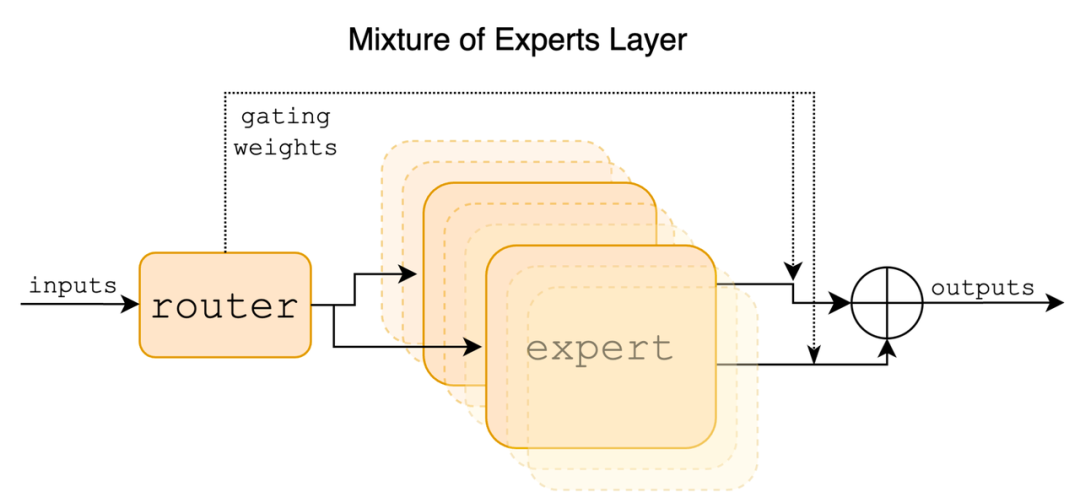
2.1 Mixtral 模型架构
In a Transformer model, the MoE layer is applied independently per token and replaces the feed-forward (FFN) sub-block of the transformer block. For Mixtral we use the same SwiGLU architecture as the expert function Ei(x) and set K = 2. This means each token is routed to two SwiGLU sub-blocks with different sets of weights. Taking this all together, the output y for an input token x is computed as:
-
以 LLaMA2或Mistral-7B来说其MLP都是SwiGLU形式 -
在 Mixtral-8x7B中 每层的Decoder层的MLP都以sMoE来替换掉
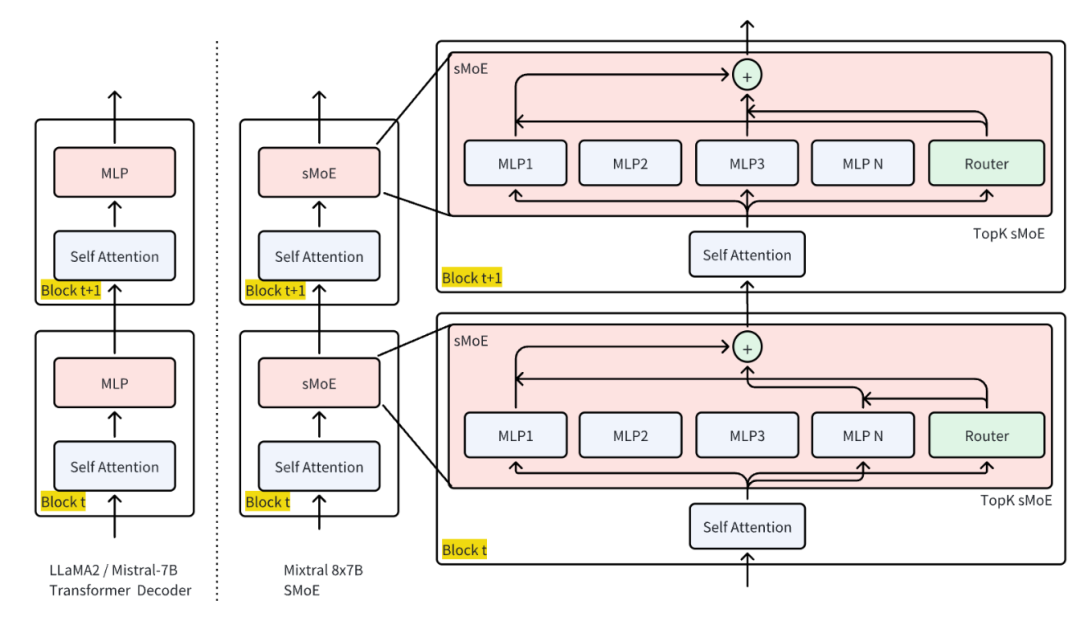
Transformers Mixtral-of-Expert
代码实现:
在Huggingface的Transformers框架中, Mixtral主要有两部分组成
-
MixtralDecoderLayer -
MixtralSparseMoeBlock:替换掉原有的MLP层
MixtralForCausalLM(
(model): MixtralModel(
(embed_tokens): Embedding(32000, 128)
(layers): ModuleList(
(1): MixtralDecoderLayer(
(self_attn): MixtralAttention(
(q_proj): Linear(in_features=128, out_features=128, bias=False)
(k_proj): Linear(in_features=128, out_features=128, bias=False)
(v_proj): Linear(in_features=128, out_features=128, bias=False)
(o_proj): Linear(in_features=128, out_features=128, bias=False)
(rotary_emb): MixtralRotaryEmbedding()
)
(block_sparse_moe): MixtralSparseMoeBlock(
(gate): Linear(in_features=128, out_features=8, bias=False)
(experts): ModuleList(
(0-7): 8 x MixtralBLockSparseTop2MLP(
(w1): Linear(in_features=128, out_features=256, bias=False)
(w2): Linear(in_features=256, out_features=128, bias=False)
(w3): Linear(in_features=128, out_features=256, bias=False)
(act_fn): SiLU()
)
)
)
(input_layernorm): MixtralRMSNorm()
(post_attention_layernorm): MixtralRMSNorm()
)
)
(norm): MixtralRMSNorm()
)
2.2 SMoE 层实现
2.2.1 单个 Expert 实现
import torch
from torch import nn
from transformers import MixtralConfig
class MixtralBLockSparseTop2MLP(nn.Module):
def __init__(self, config: MixtralConfig):
super().__init__()
self.ffn_dim = config.intermediate_size
self.hidden_dim = config.hidden_size
self.w1 = nn.Linear(self.hidden_dim, self.ffn_dim, bias=False)
self.w2 = nn.Linear(self.ffn_dim, self.hidden_dim, bias=False)
self.w3 = nn.Linear(self.hidden_dim, self.ffn_dim, bias=False)
self.act_fn = nn.SiLU()
# Forward 是 SwiGLU
def forward(self, hidden_states):
y = self.act_fn(self.w1(hidden_states)) * self.w3(hidden_states)
y = self.w2(y)
return y
x = torch.randn(1, 64, 128)
expert = MixtralBLockSparseTop2MLP(config)
print('单个专家为原LLaMA的MLP层')
print(expert)
g = expert(x)
print('单个专家输入:', x.shape)
print('单个专家输出结果:', g.shape)结果
单个专家为原LLaMA的MLP层
MixtralBLockSparseTop2MLP(
(w1): Linear(in_features=128, out_features=256, bias=False)
(w2): Linear(in_features=256, out_features=128, bias=False)
(w3): Linear(in_features=128, out_features=256, bias=False)
(act_fn): SiLU()
)
单个专家输入:
torch.Size([1, 64, 128])
单个专家输出结果:
torch.Size([1, 64, 128])
2.2.2 混合Expert实现
class MixtralSparseMoeBlock(nn.Module):
def __init__(self, config):
super().__init__()
self.hidden_dim = config.hidden_size
self.ffn_dim = config.intermediate_size
self.num_experts = config.num_local_experts
self.top_k = config.num_experts_per_tok
# gating
self.gate = nn.Linear(self.hidden_dim, self.num_experts, bias=False)
# 多个 SwiGLU MLP 层组成混合专家
self.experts = nn.ModuleList([MixtralBLockSparseTop2MLP(config) \
for _ in range(self.num_experts)])
x = torch.randn(1, 64, 128)
experts = MixtralSparseMoeBlock(config)
print('多个专家混合专家')
print(experts)
在以上我们实现了模型的关键结构, 但是这里的sMoE的Forward并没有实现
2.3 SMoE 计算流程

2.3.1 Gating流程
以下表示为多个token的gating计算流程
# 阶段一
# 计算稀疏 gating 值
tokens = 6
x = torch.randn(1, tokens, 128) # 6个token
hidden_states = x
batch_size, sequence_length, hidden_dim = hidden_states.shape
hidden_states = hidden_states.view(-1, hidden_dim)
# 每层都会产生router_logits, 将用于最后作 load balance loss
router_logits = experts.gate(hidden_states)
print(f'experts.gate output router logits : \n {router_logits}')
# 计算 TopK 的 专家 logits 和 Top2 专家的位置
routing_weights = F.softmax(router_logits, dim=1, dtype=torch.float)
print(f'softmax weight : \n {routing_weights}')
routing_weights, selected_experts = torch.topk(routing_weights, \
experts.top_k, dim=-1)
print(f'expert select : \n {selected_experts}')
print(f'topk : \n {routing_weights}')
routing_weights /= routing_weights.sum(dim=-1, keepdim=True)
print(f'topk归一化 : \n {routing_weights}')
routing_weights = routing_weights.to(hidden_states.dtype)
## One Hot 编码
expert_mask = torch.nn.functional.one_hot(selected_experts, \
num_classes=experts.num_experts).permute(2, 1, 0)
for i in range(tokens):
print(f'【token_{i}】\n', expert_mask[:,:,i])
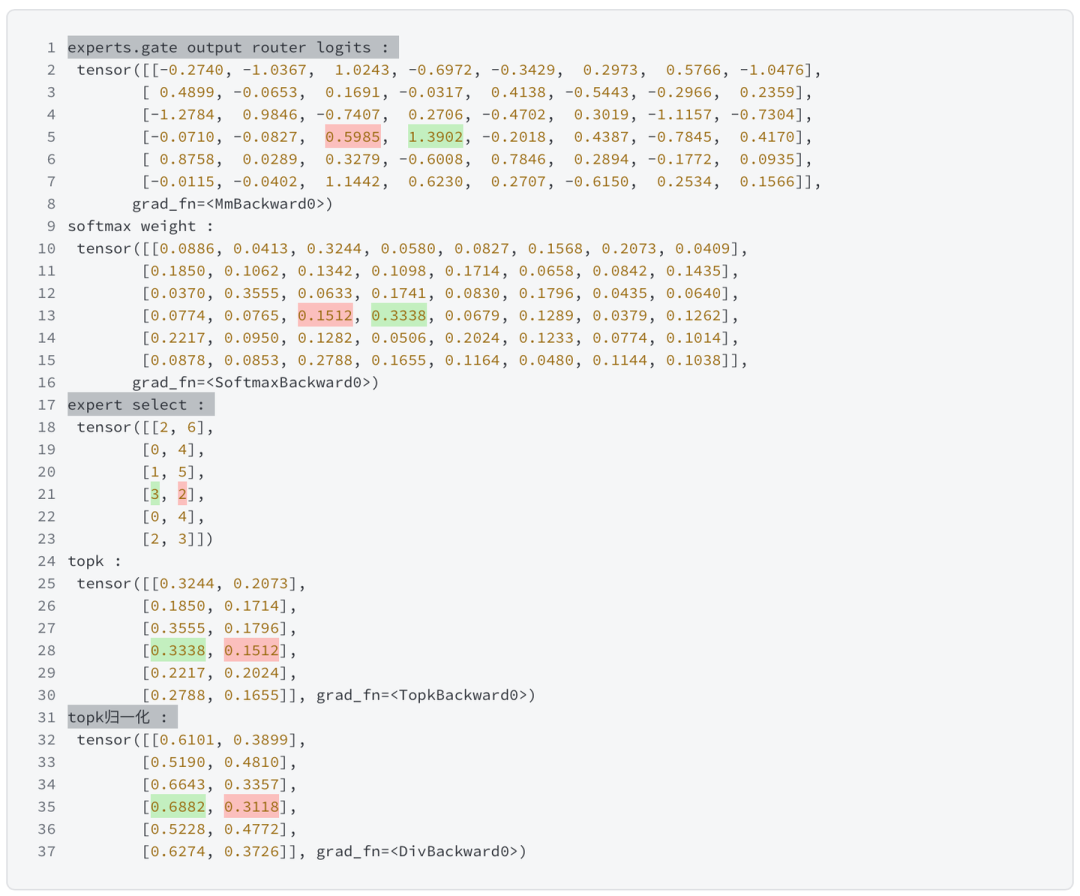
追踪x3的结果

2.3.2 Expert 流程
-
sMoE中是基于专家来选择token来计算的 -
token先序:左图为token3选择expert 2,expert 3号来计算sMoE结果 -
expert先序:右图为依次计算expert2和expert3才得出token3的sMoE结果
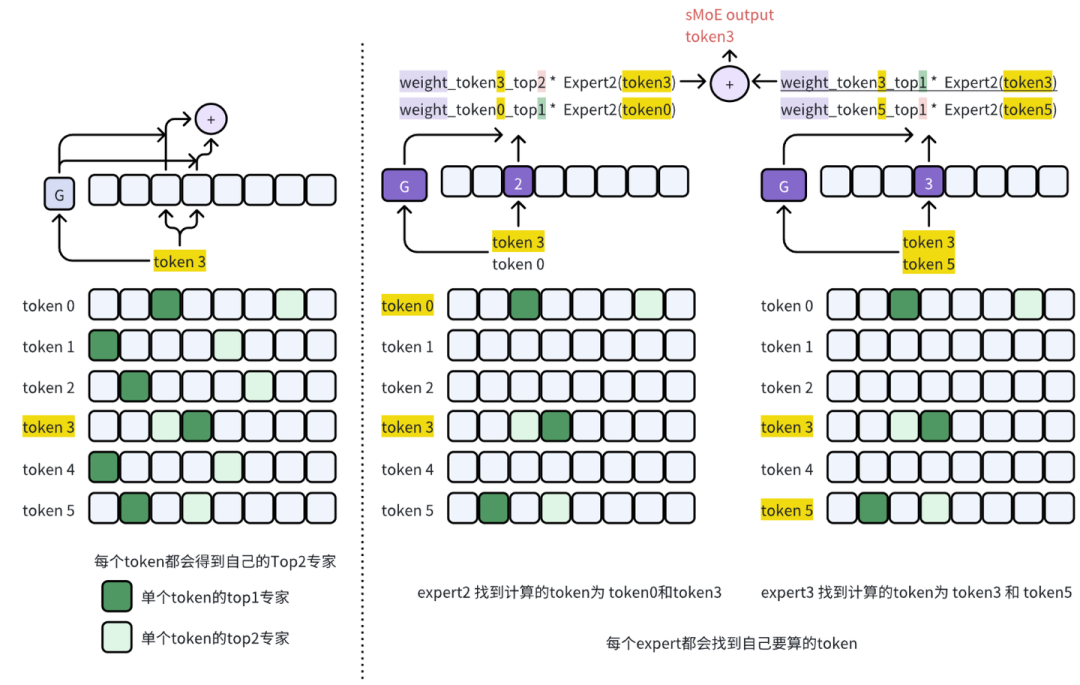
代码实现结果为:
## 最终结果
final_hidden_states = torch.zeros(
(batch_size * sequence_length, hidden_dim), \
dtype=hidden_states.dtype, device=hidden_states.device
)
print(f'final moe result shape for each token: {final_hidden_states.shape}')
# 每个专家收集需要计算token
for expert_idx in range(experts.num_experts):
print(f'--------expert {expert_idx} ---------')
expert_layer = experts.experts[expert_idx]
print(expert_mask[expert_idx])
idx, top_x = torch.where(expert_mask[expert_idx])
print(f'专家 {expert_idx} 计算的样本编号:',top_x.tolist()) # select x_idx for expert top1
print(f'专家 {expert_idx} top1:0, top2:1 ',idx.tolist()) # 0 is top1 ,1 is top2
print(f'有 {len(top_x)} / {x.shape[1]} token 选到专家 {expert_idx}')
top_x_list = top_x.tolist()
idx_list = idx.tolist()
current_state = hidden_states[None, top_x_list].reshape(-1, hidden_dim)
# expert_0(x) * routing_weights
current_hidden_states = expert_layer(current_state) \
* routing_weights[top_x_list, idx_list, None]
# 将计算的单个专家结果填入到结果表里
final_hidden_states.index_add_(0, top_x, current_hidden_states.to(hidden_states.dtype))
print(current_state.shape)
print(routing_weights[top_x_list, idx_list, None].shape)
print(current_hidden_states.shape)
print(final_hidden_states.shape)
输出结果为:
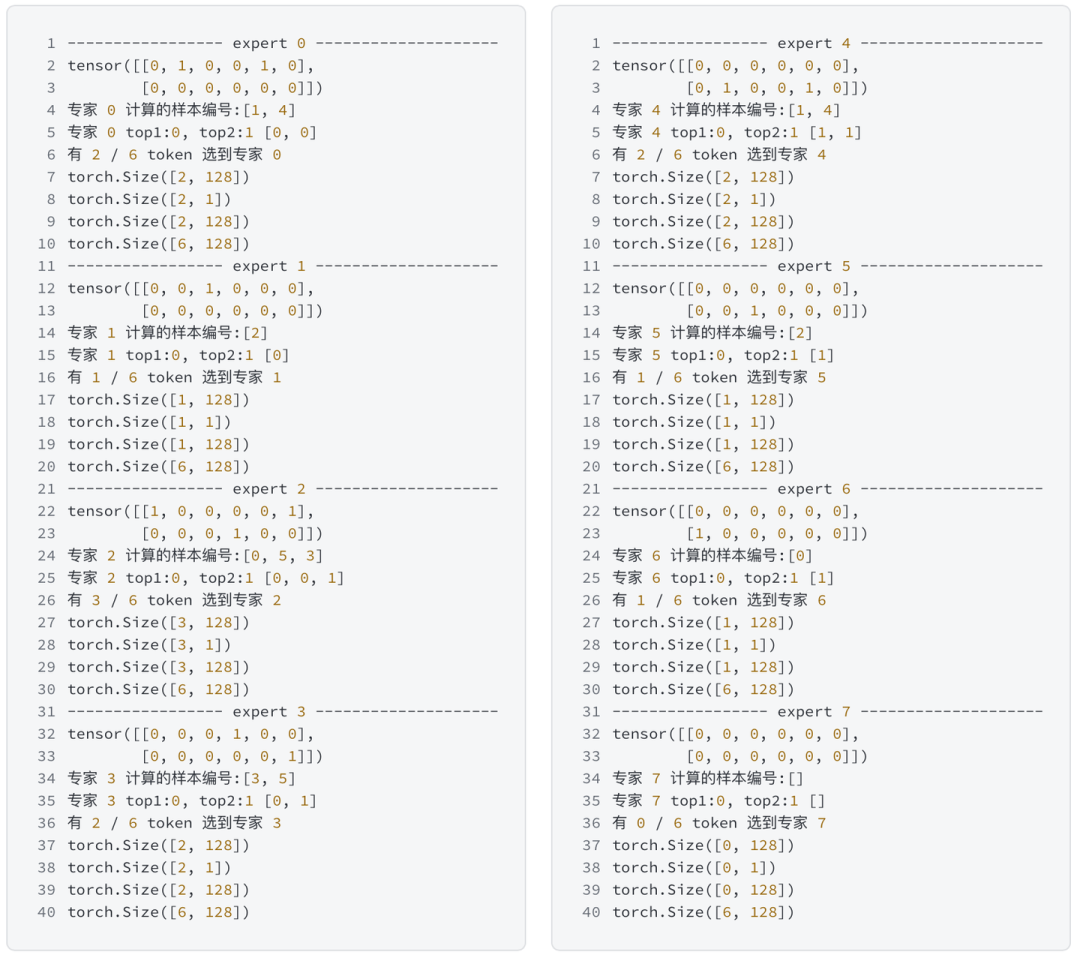
2.4 Router Load Balence 计算
路由负载均衡的实现来自Switch Transformers
Computes auxiliary load balancing loss as in Switch Transformer - implemented in Pytorch. See Switch Transformer for more details. This function implements the loss function presented in equations (4) - (6) of the paper. It aims at penalizing cases where the routing between experts is too unbalanced.
2.4.1 Switch Transformers Load Balance Loss
该算法为sMoE简化版load balance , 去除了原版 balance loss 估计
fi:在一个batch中第i专家分配到token的数量概率
Pi:在一个batch中T个tokens,各个专家选到tokens的概率和
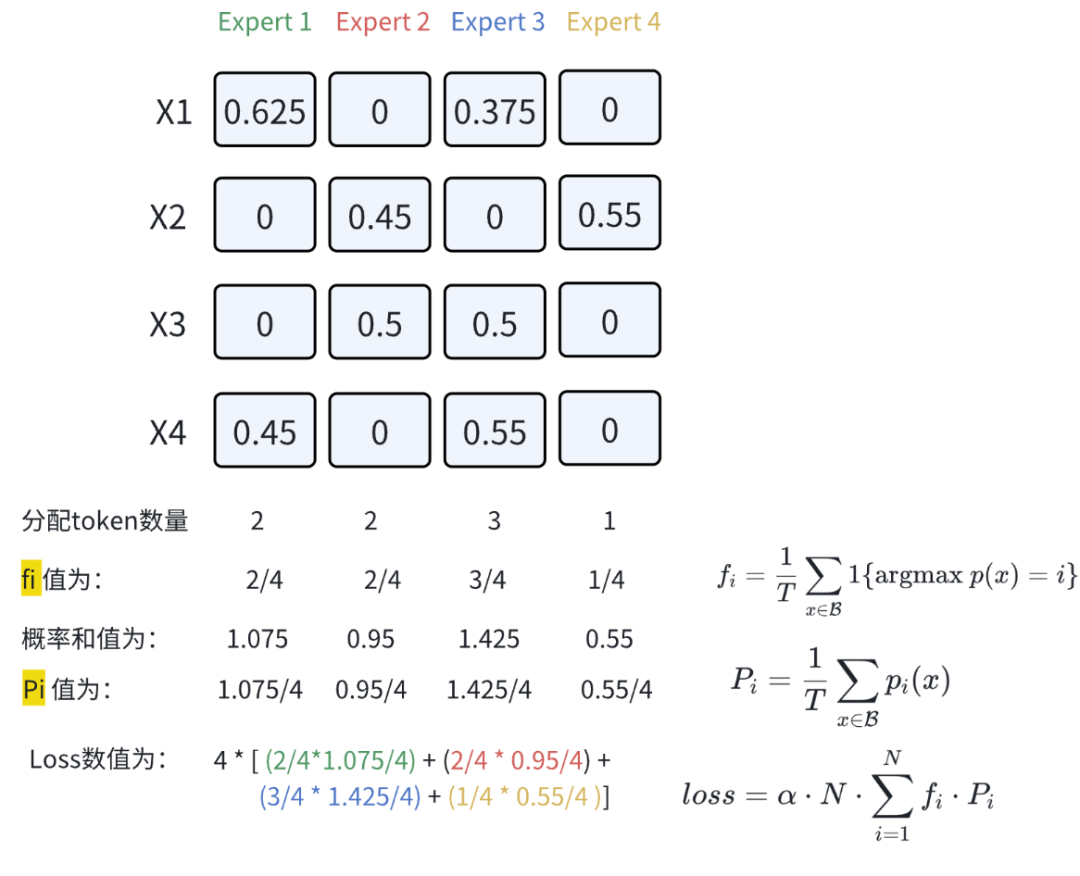
可以想象下layer norm只是在当前层里对所有tokens 做,而负载均衡处理范围更广,对所有层的tokens ,在每个expert的纵向计算出单专家负载值,求和便得到整个网络的负载均衡 loss
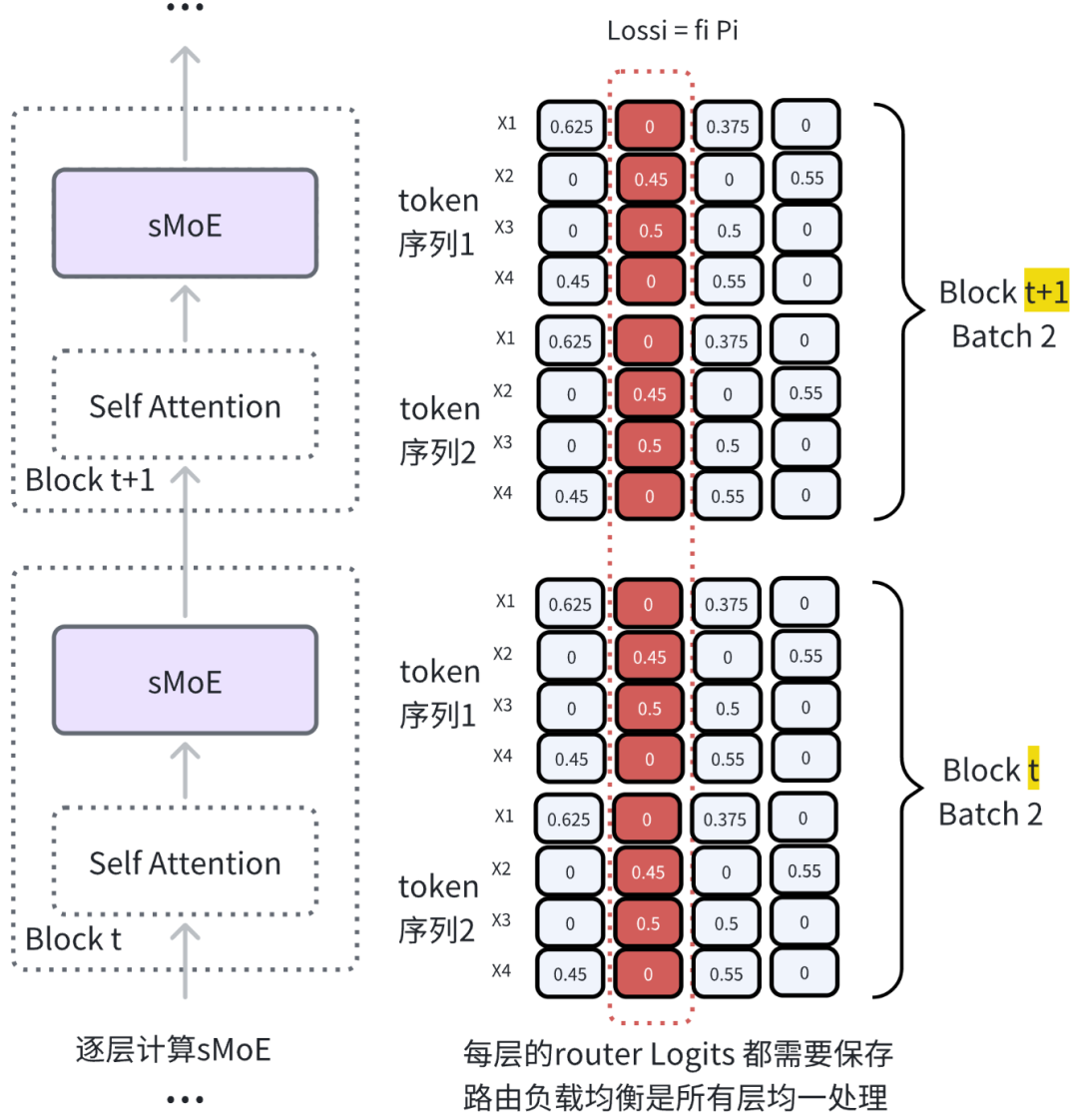
2.4.3 手撕Mixtral Load Balance
import torch
num_experts = 8
batch = 10
seq_length = 6
top_k = 2
print(f'sMoE num_experts:{num_experts} top_k:{top_k} batch:{batch} seq_length:{seq_length}')
router_logits_1 = torch.randn(batch, seq_length, num_experts).view(-1,num_experts) # layer 1
router_logits_2 = torch.randn(batch, seq_length, num_experts).view(-1,num_experts) # layer 2
router_logits = [router_logits_1, router_logits_2]
concatenated_gate_logits = torch.cat(router_logits, dim = 0)
print('单层gating的路由logits:', router_logits_1.shape)
print('两层gating的路由logits:', concatenated_gate_logits.shape)
print('根据logits top-k 计算热独编码')
routing_weights = torch.nn.functional.softmax(concatenated_gate_logits, dim=-1)
_, selected_experts = torch.topk(routing_weights, top_k, dim=-1)
expert_mask = torch.nn.functional.one_hot(selected_experts, num_experts)
print(expert_mask.shape)
tokens_sum_expert = torch.sum(expert_mask.float(), dim=0)
tokens_per_expert = torch.mean(expert_mask.float(), dim=0)
print(f'top1 每个专家平均处理的token :', tokens_sum_expert[0])
print(f'top2 每个专家平均处理的token fi:', tokens_per_expert[1])
print(f'top1与top2水平合计', tokens_per_expert.sum(dim=1))
# Compute the average probability of routing to these experts
router_prob_per_expert = torch.mean(routing_weights, dim=0)
print('router_prob_per_expert Pi: ' , router_prob_per_expert)
print( '每个专家的负载:', tokens_per_expert * router_prob_per_expert.unsqueeze(0))
overall_loss = torch.sum(tokens_per_expert * router_prob_per_expert.unsqueeze(0))
print('final loss:', overall_loss)
计算结果
sMoE num_experts:8 top_k:2 batch:10 seq_length:6
单层gating的路由logits:
torch.Size([60, 8])
两层gating的路由logits:
torch.Size([120, 8])
根据logits top-k 计算热独编码
torch.Size([120, 2, 8])
top1 每个专家平均处理的token : tensor([10., 14., 19., 17., 14., 9., 17., 20.])
top2 每个专家平均处理的token fi: tensor([0.1667, 0.1333, 0.1833, 0.0833, 0.1167, 0.1500, 0.0667, 0.1000])
top1与top2水平合计 tensor([1., 1.])
router_prob_per_expert Pi: tensor([0.1236, 0.1184, 0.1351, 0.1168, 0.1311, 0.1147, 0.1156, 0.1447])
每个专家的负载:tensor([[0.0103, 0.0138, 0.0214, 0.0165, 0.0153, 0.0086, 0.0164, 0.0241],
[0.0206, 0.0158, 0.0248, 0.0097, 0.0153, 0.0172, 0.0077, 0.0145]])
final loss: tensor(0.2520)
这里的gating logits 是跨batch跨层的,作用在每个token上
3. Mixtral 8x7B 参数量计算
3.1 原论文描述
这里的13B 是指单个 token涉及的模型参数量,实际推理时每个token都有不同的expert ,那么实际运行还是跑47B 参数的, 使用了sMoE 并不会减少显存占用。
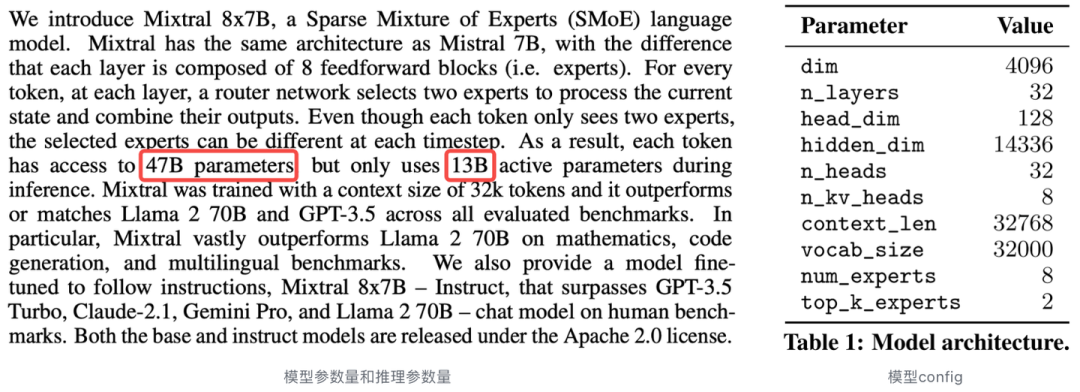
3.2 模型参数量计算
忽略GQA计算
dim = 4096
n_layers = 32
head_dim = 128
hidden_dim = 14336
n_heads = 32
n_kv_heads = 8# ignore GQA
vocab_size = 32000
num_experts = 8
top_k_experts = 2
# attention mlp layernorm
llama_num = n_layers * (dim * dim * 4 + hidden_dim * dim * 3 + 2 * dim ) \
+ 2 * vocab_size * dim
print('llama:', llama_num)
# attention 【mlp*8】 layernorm
moe_num = n_layers * (dim * dim * 4 + hidden_dim * dim * 3 * 8 + 2 * dim ) \
+ 2 * vocab_size * dim
print('moe:', moe_num)
# attention 【mlp*2】 layernorm
# ToP2-inference
moe_num = n_layers * (dim * dim * 4 + hidden_dim * dim * 3 * 2 + 2 * dim ) \
+ 2 * vocab_size * dim
print('moe top-2:', moe_num)
结果
llama: 8047034368
moe: 47507046400
moe top-2: 13684178944
4. MoE 扩展
4.1 MegaBlocks
MoE layers can be run efficiently on single GPUs with high performance specialized kernels. For example, Megablocks
MegaBlocks实现稀疏的MoE计算

题外话:XFormers也实现了类似思想的算子,batch里的attention通过Mask实现多序列稀疏计算。

4.2 GShard
Mixtral论文里在load balance里提了一下GShard, 是首篇将MoE引入到Transformers的工作
This formulation is similar to the GShard architecture [21], with the exceptions that we replace all FFN sub-blocks by MoE layers while GShard replaces every other block, and that GShard uses a more elaborate gating strategy for the second expert assigned to each token.
GShard在不同GPU上分配不同的专家,其他参数都共享,数据派发到专家,专家结果汇总都由All-to-All算子实现
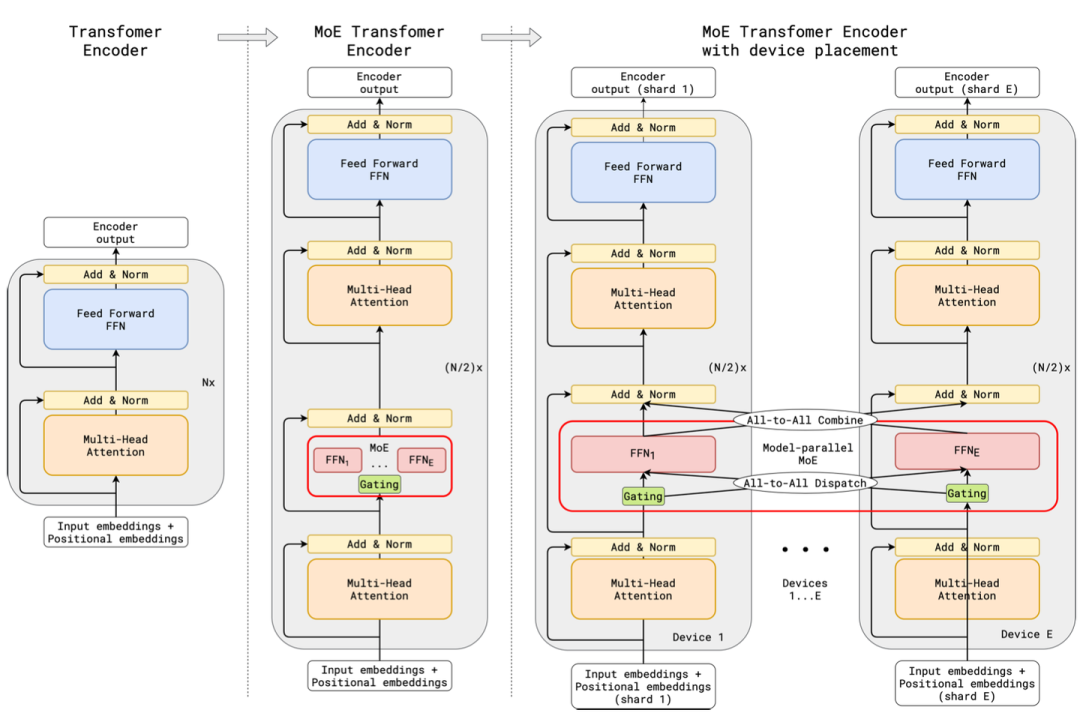
DeepSpeed-MoE源码对All-to-All的实现如下
class _AllToAll(torch.autograd.Function):
@staticmethod
def forward(
ctx: Any,
# TODO: replace with DS process group
group: torch.distributed.ProcessGroup,
input: Tensor) -> Tensor:# type: ignore
ctx.group = group
input = input.contiguous()
output = torch.empty_like(input)
dist.all_to_all_single(output, input, group=group)
return output
@staticmethod
def backward(ctx: Any, *grad_output: Tensor) -> Tuple[None, Tensor]:
return (None, _AllToAll.apply(ctx.group, *grad_output))
class MOELayer(Base):
# ...
def forward(self, *input: Tensor, **kwargs: Any) -> Tensor:
# ...
dispatched_input = _AllToAll.apply(self.ep_group, dispatched_input)
# Re-shape after all-to-all: ecm -> gecm
dispatched_input = dispatched_input.reshape(self.ep_size, self.num_local_experts, -1, d_model)
expert_output = self.experts(dispatched_input)
expert_output = _AllToAll.apply(self.ep_group, expert_output)
#...
4.3 DeepSpeed-MoE
-
更加工程化的实现可以看 DeepSpeed-MoE的开源方案 -
MoE层使用Expert-Paralallelism做并行AlltoAll实现如上 -
非 MoE层使用TP+DP
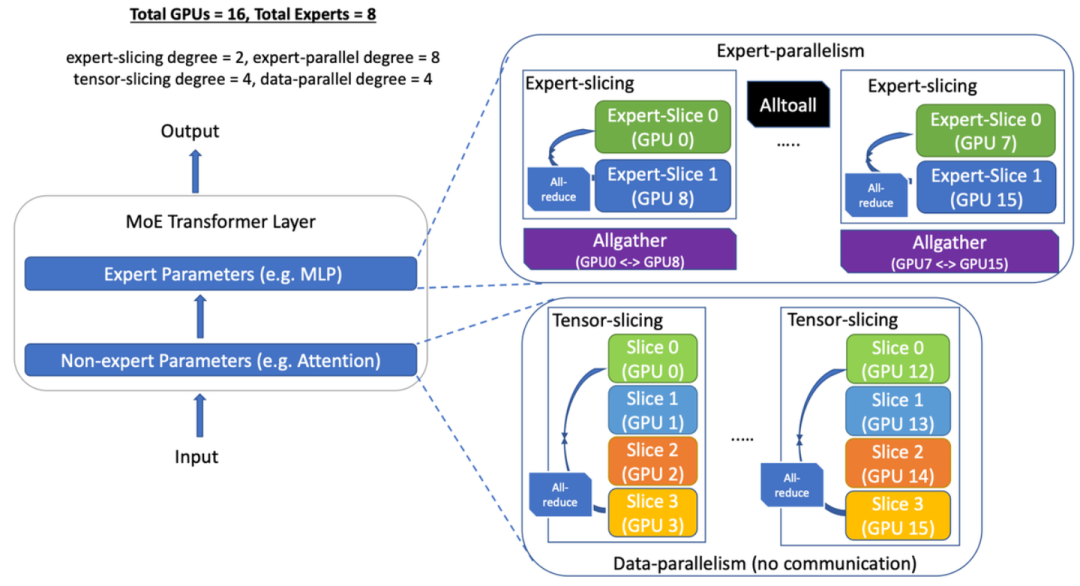
4.4 LLaMA-MoE
Mixtral 8x7B训不动?试试将LLaMA原MLP改造成LLaMA-MoE
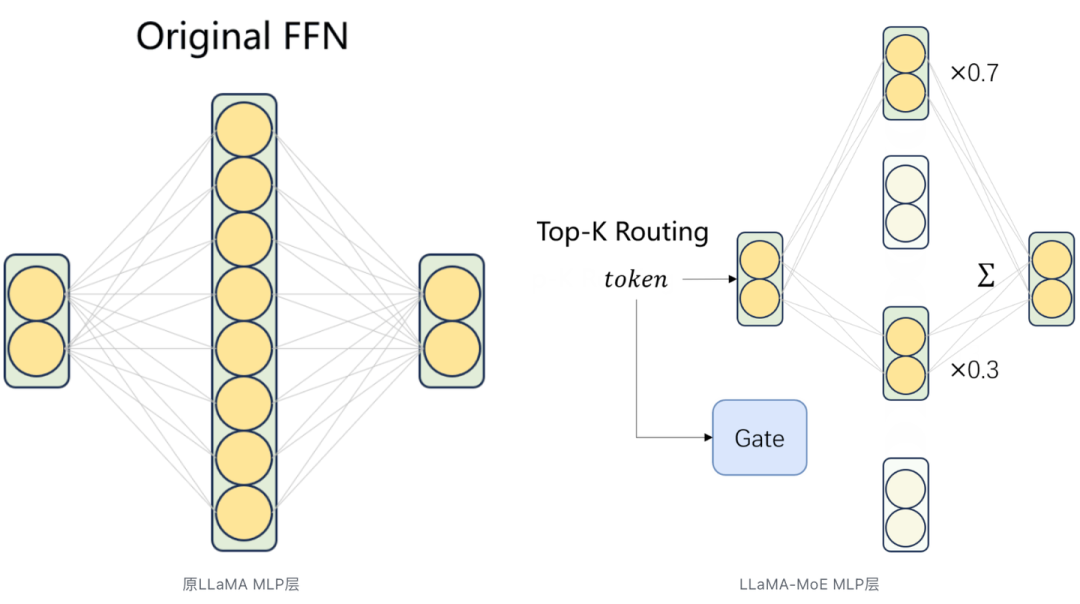
LLaMA-MoE 上关键代码是用LinearGLUExperts代替原本LLaMA里的SwiGLU层
class LinearGLUExperts(nn.Module):
# ...
def __init__(...):
# ...
# 每个专家都创建SwiGLU MLP层
for i in range(num_experts):
# this matrix will be transposed when performing linear forwarding
this_expert_weight_gate = nn.Parameter(
torch.empty((size_experts[i], in_features), **factory_kwargs)
)
# this matrix will be transposed when performing linear forwarding
this_expert_weight_up = nn.Parameter(
torch.empty((size_experts[i], in_features), **factory_kwargs)
)
# this matrix will be transposed when performing linear forwarding
this_expert_weight_down = nn.Parameter(
torch.empty((out_features, size_experts[i]), **factory_kwargs)
)
self.weight_gate.append(this_expert_weight_gate)
self.weight_up.append(this_expert_weight_up)
self.weight_down.append(this_expert_weight_down)
# ...
5. Mixtral 8x7B 总结 & 进一步阅读
-
Mixtral 8x7B实现并不复杂,其中load-balance loss是expert-wise维度计算的 -
当前发布的模型还是围绕模型结构展开的, 期待 mistral.AI上线创新的对齐方案 -
涉及到多机多卡的 sMoE分布式训练非常需要工程技巧, 不同的模型架构和集群可以有多种DP\TP\EP..组合方案, -
在·Mixtral·中对于实验反直觉论点 专家的知识是作用在 token 级别,而不是domain级别,对 MoE 感兴趣的话可以进一步开盒分析
Reference
-
Mixture of Experts Explained -
方佳瑞:MoE训练论文解读之Megablocks:打破动态路由限制 -
方佳瑞:MoE训练系统之JANUS:参数服务器助力MoE训练 -
方佳瑞:MoE训练论文解读之Tutel: 动态切换并行策略实现动态路由 -
西门宇少:对MoE大模型的训练和推理做分布式加速——DeepSpeed-MoE论文速读 -
吃果冻不吐果冻皮:大模型分布式训练并行技术(八)-MOE并行 -
孟繁续:Mixtral-8x7B 模型挖坑 -
Mixtral-of-experts -
Mistral-7B -
Gshard -
Switch Transformers -
sMoE -
Transformers-Mixtral-of-Experts -
DeepSpeed-MoE -
Megablocks -
LLaMA-MoE
本文由 Hugging Face 中文社区内容共建项目提供,稿件由社区成员投稿,经授权发布于 Hugging Face 公众号。文章内容不代表官方立场,文中介绍的产品和服务等均不构成投资建议。了解更多请关注公众号:
如果你有与开源 AI、Hugging Face 相关的技术和实践分享内容,以及最新的开源 AI 项目发布,希望通过我们分享给更多 AI 从业者和开发者们,请通过下面的链接投稿与我们取得联系:
本文分享自微信公众号 - Hugging Face(gh_504339124f0f)。
如有侵权,请联系 support@oschina.cn 删除。
本文参与“OSC源创计划”,欢迎正在阅读的你也加入,一起分享。




